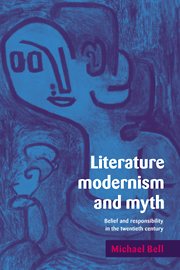1 - Myth in the age of the world view
Published online by Cambridge University Press: 18 December 2009
Summary
Martin Heidegger described modernity as the ‘age of the world picture’:
The expressions ‘world picture of the modern age’ and ‘modern world picture’ both mean the same thing and both assume something that never could have been before, namely, a medieval world picture and an ancient world picture. The world picture does not change from an earlier medieval one into a modern one, but rather the fact that the world becomes picture at all is what distinguishes the essence of the modern age.
He claims not just that there is a distinctively modern world picture, but that the characteristic feature of modernity is to be aware of this relativity. The general recognition Heidegger defines came crucially into consciousness in the teens and twenties of the century when the consciousness of living a world view as a world view was instantiated in a number of literary and philosophical works. The present chapter retraces some of the essential movements of thought that led up to this recognition, and their relation to the term ‘myth’, while subsequent chapters will show in turn something of its reflection in the literary texts of the teens and then of its aftermath throughout the century.
Immanuel Kant's Critique of Pure Reason (1781) answered the idealism of Berkeley and the scepticism of Hume by showing how the world is a construction of the human mind according to necessary categories of thought.
- Type
- Chapter
- Information
- Literature, Modernism and MythBelief and Responsibility in the Twentieth Century, pp. 9 - 38Publisher: Cambridge University PressPrint publication year: 1997



